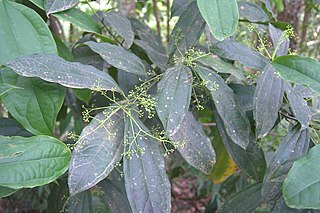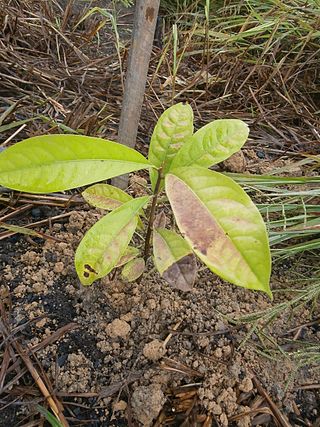
Lauraceae, or the laurels, is a plant family that includes the true laurel and its closest relatives. This family comprises about 2850 known species in about 45 genera worldwide. They are dicotyledons, and occur mainly in warm temperate and tropical regions, especially Southeast Asia and South America. Many are aromatic evergreen trees or shrubs, but some, such as Sassafras, are deciduous, or include both deciduous and evergreen trees and shrubs, especially in tropical and temperate climates. The genus Cassytha is unique in the Lauraceae in that its members are parasitic vines. Most laurels are highly poisonous.

Persea is a genus of about 150 species of evergreen trees belonging to the laurel family, Lauraceae. The best-known member of the genus is the avocado, P. americana, widely cultivated in subtropical regions for its large, edible fruit.

Ocotea is a genus of flowering plants belonging to the family Lauraceae. Many are evergreen trees with lauroid leaves.

Litsea is a genus of evergreen or deciduous trees or shrubs belonging to the laurel family, Lauraceae. The genus includes a large number of accepted species in tropical and subtropical areas of North America and Asia.

Endiandra is a genus of about 126 species of plants, mainly trees, in the laurel family Lauraceae. They are commonly called "walnut" despite not being related to the Northern Hemisphere walnuts which are in the family Juglandaceae.

Actinodaphne is an Asian genus of flowering plants in the laurel family (Lauraceae). It contains approximately 125 species of dioecious evergreen trees and shrubs.

Aiouea is a genus of shrubs and trees in the family Lauraceae. It is native to tropical forests and montane forests of North and South America. The name is a curiosity because it consists entirely of vowels.

Aniba is an American neotropical flowering plant genus in the family Lauraceae. They are present in low and mountain cloud forest in Caribbean islands, Central America, and northern to central South America.

Beilschmiedia is a genus of trees and shrubs in family Lauraceae. Most of its species grow in tropical climates, but a few of them are native to temperate regions, and they are widespread in tropical Asia, Africa, Madagascar, Australia, New Zealand, North America, Central America, the Caribbean, and South America. The best-known species to gardeners in temperate areas are B. berteroana and B. miersii because of their frost tolerance. Seeds of B. bancroftii were used as a source of food by Australian Aborigines. Timbers of some species are very valuable.

Licaria is a flowering plant genus in the family Lauraceae, native to Central America and South America. It is a Neotropical genus with around 80 species.

Mezilaurus is a genus of plant in the family Lauraceae. It is a neotropical genus consisting of 18-27 species, mostly hardwood evergreen trees, occurring from Costa Rica to the southeast of Brazil. Thirteen species have been identified in Brazil, distributed mostly in the Amazon region. In Rio de Janeiro state only M. navalium (Allemão) Taub. ex Mez has been recorded. Some species have been reported within the Cerrado and in semideciduous forest surrounding the Pantanal Matogrossense. The name Mezilaurus refers to its similar appearance to the genus Laurus.
Pleurothyrium is a genus of flowering plants in the family Lauraceae. It includes 48 species, which are native to Central America and northern South America. Many of the species were first described in a 1993 revision of the genus.
Aspidostemon is a genus of flowering plants belonging to the family Lauraceae. It occurs in Madagascar.

Dehaasia is a genus of evergreen or deciduous trees or shrubs belonging to the laurel family, Lauraceae, with 53 species native to continental Asia, from India to China, and islands of Borneo, New Guinea, and Indonesia.
Rhodostemonodaphne is a genus of flowering plants in the family Lauraceae. It is a neotropical genus consisting of approximately 41 species occurring in Central America and northern South America. This genus has many species that are valued for timber. The classification of the genus is unclear since the species in the genus fall into a well-supported but unresolved clade that also includes species with unisexual flowers currently placed in the genera Endlicheria and part of Ocotea.
Kubitzia is an American neotropical flowering plant genus in the family Lauraceae with two species from South America.

Damburneya is a genus of evergreen trees and shrubs in the laurel family (Lauraceae). It is native to tropical regions of North America and South America, with the center of diversity in Central America.













